900M+ iOS and Android activations

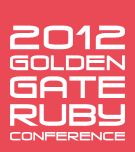
What's so interesting about the browser - right? Wrong. Everything!
The browser is an operating system - increasingly, literally...
It's up to you to fill in the gaps...
Web performance for the curious
- A browser is a "big thing", where do I begin?
- What are the major building blocks?
- How do I continue to explore this on my own?
A crash course in 25 minutes, or less... to get you started...

- WebKit comes in a white box - progress!
- An open white box!
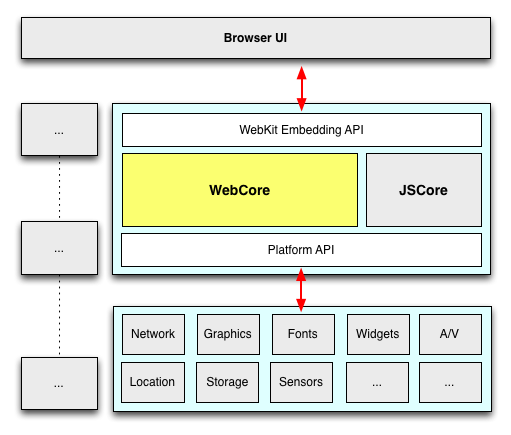
"WebKit is an open source web browser engine."
- A browser consists of many components...
- WebKit provides a platform API and an embedding API
- WebKit is not a "browser" on its own
- WebKit ships with many swappable component implementations (gray)
- Some components must be provided
- Some components can use defaults

WebCore
- Resource dispatch & loading
- Parsing
- DOM construction
- Layout, style resolution, painting
- Event handling
- JavaScript bindings
- ...
The fun hard stuff.

JavaScript Engine
"WebKit's JavaScript engine, JavaScriptCore, based on KJS, is a framework separate from WebCore and WebKit, and is used on Mac OS X for applications other than web page JavaScript."
- JavaScriptCore ships by default
- Interpreter + JIT
- Can be swapped, e.g. V8

Platform API's
- Native widget implementations
- Font rendering
- Rendering / paint engine
- Audio / Video codecs
- Networking
- JavaScript engine
- ...
Performance, visual output, speed, security, capabilities all vary based on platform implementation.
WebKit Powered Browsers
Small sample of the many differences...
| Chrome (OSX) | WebKitGTK | Android Browser | Chrome for iOS | |
|---|---|---|---|---|
| Rendering | Skia | Cairo | Android stack | CoreGraphics |
| Networking | Own Chrome stack | Soup | Android stack | Own Chrome stack |
| Fonts | Quartz | Pango | Android stack | Quartz |
| JavaScript | V8 | JavaScriptCore | V8 | JavaScriptCore (no JIT) * |
| ... | ... | ... | ... | ... |
Putting it together
What does it take to render a page?
- network
- server
- browser execution
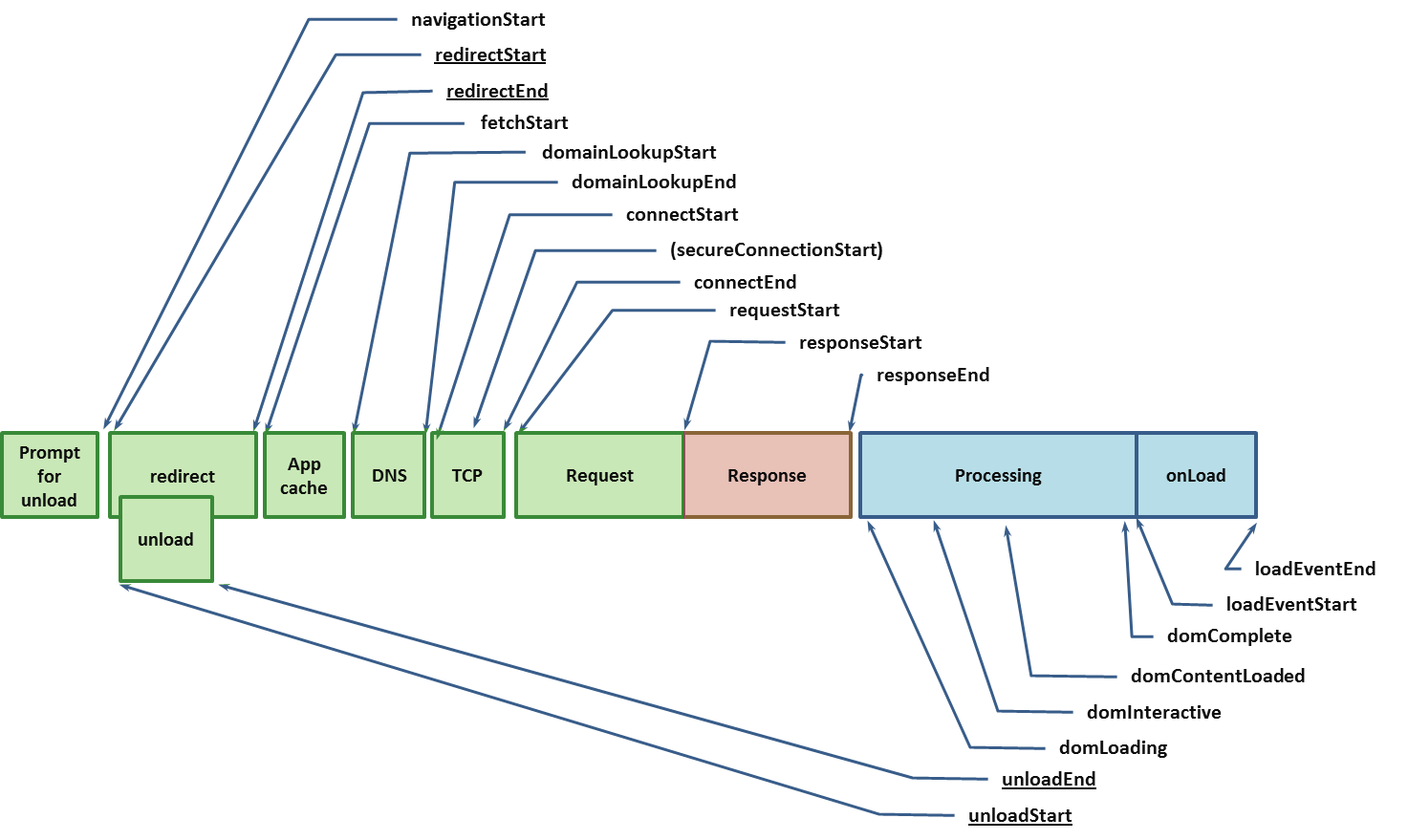
(Chrome) Network Stack
An average page has grown to 1059kB (over 1MB!) and is now composed of 80+ subresources.
- DNS prefetch - pre-resolve hostnames before we make the request
- TCP preconnect - establish connection before we make the request
- Pooling & re-use - leverage keep-alive, re-use existing connections (6 per host)
- Caching - fastest request is request not made (sizing, validation, eviction, etc)
Ex, Chrome learns subresource domains:

(Chrome) Networking Stack
- chrome://predictors - omnibox predictor stats (check 'Filter zero confidences')
- chrome://net-internals#sockets - current socket pool status
- chrome://net-internals#dns - Chrome's in-memory DNS cache
- chrome://histograms/DNS - histograms of your DNS performance
- chrome://dns - startup prefetch list and subresource host cache
enum ResolutionMotivation {
MOUSE_OVER_MOTIVATED, // Mouse-over link induced resolution.
PAGE_SCAN_MOTIVATED, // Scan of rendered page induced resolution.
LINKED_MAX_MOTIVATED, // enum demarkation above motivation from links.
OMNIBOX_MOTIVATED, // Omni-box suggested resolving this.
STARTUP_LIST_MOTIVATED, // Startup list caused this resolution.
EARLY_LOAD_MOTIVATED, // In some cases we use the prefetcher to warm up the connection
STATIC_REFERAL_MOTIVATED, // External database suggested this resolution.
LEARNED_REFERAL_MOTIVATED, // Prior navigation taught us this resolution.
SELF_REFERAL_MOTIVATED, // Guess about need for a second connection.
// ...
};
Best request is no request. Worst request is one that blocks the parser.
<!doctype html> <meta charset=utf-8> <title>Awesome HTML5 page</title> <script src=application.js></script> <link href=styles.css rel=stylesheet /> <p>I'm awesome.
HTMLDocumentParser begins parsing the received data...
HTML
- HEAD
- META charset="utf-8"
- TITLE
#text: Awesome HTML5 page
- SCRIPT src="application.js"
** stop **
Stop. Dispatch request for application.js. Wait...
<script> could doc.write, stop the world!
Preload Scanner to the rescue!
if (isWaitingForScripts()) {
ASSERT(m_tokenizer->state() == HTMLTokenizerState::DataState);
if (!m_preloadScanner) {
m_preloadScanner = adoptPtr(new HTMLPreloadScanner(document()));
m_preloadScanner->appendToEnd(m_input.current());
}
m_preloadScanner->scan();
}
HTMLPreloadScanner forges ahead, looking for blocking resources...
if (m_tagName != imgTag
&& m_tagName != inputTag
&& m_tagName != linkTag
&& m_tagName != scriptTag
&& m_tagName != baseTag)
return;
Flush early, flush often

- Network Predictor can run DNS prefetch & TCP-preconnect
- PreloadScanner can fetch resources while parser is blocked
- Early flush example: https://gist.github.com/3058839
// quick and dirty test.. show me those packets! $> tcpdump -i en0 -A -n -s0 -vv tcp $> curl www.igvita.com
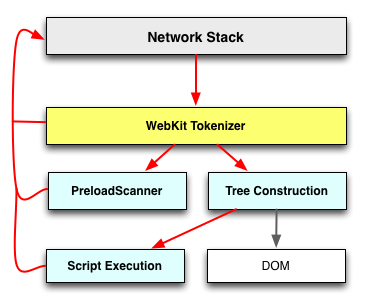
Let the browser do its job...
- Flush early, flush often, flush smart
- Time to first packet matters when...
- Content of first packet can tip-off the parser
- CSSPreloadScanner scans for @import's only
- Scheduling resources from scripts is expensive
- Don't hide resources from the parser!
Let's build a Render tree...
Or, maybe an entire forest?
Welcome to the Render forest!

- Some trees share objects
- Independently constructed
- Lazy construction
- Defer everything!

| RenderObject Tree | StyleObject Tree | RenderLayer Tree |
|---|---|---|
| owned by DOM tree | computed styles for all renderers | "helper" class for rendering |
| rendered content only | owned by RenderObject tree | used for <video>, <canvas>, ... |
| responsible for layout & paint | RenderObjects share RenderStyles | Some RenderLayers have GPU layers |
| answers DOM API measurement requests | RenderStyles share data members | ... |
Querying layout forces a flush & breaks "lazy" evaluation - e.g., offsetWidth, offsetHeight.
60FPS? That's for games and stuff, right?
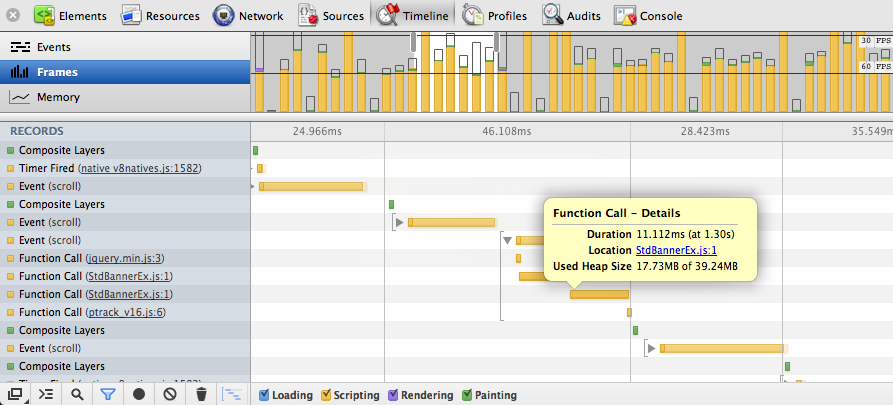
- 60FPS affords you a 16.6ms budget per frame
- StdBannerEx.js is executing 20ms+ of JavaScript on every scroll event ... <facepalm />
- It's better to be at consistent 30FPS then jump between variable frame-rates
Hardware Acceleration 101

- A RenderLayer can have a GPU backing store
- Certain elements are GPU backed automatically (canvas, video, CSS3 animations, ...)
- Forcing a GPU layer: -webkit-transform:translateZ(0)
- GPU is really fast at compositing, matrix operations and alpha blends
- (1) The object is painted to a buffer (texture)
- (2) Texture is uploaded to GPU
- (3) Send commands to GPU: apply X to texture Y
- Minimize CPU-GPU interactions
- Texture uploads are not free
- No upload: position, size, opacity
- Texture upload: everything else
CSS3 Animations are as close to "free lunch" as you can get **
<style>
.spin:hover {
-webkit-animation: spin 2s infinite linear;
}
@-webkit-keyframes spin {
0% { -webkit-transform: rotate(0deg);}
100% { -webkit-transform: rotate(360deg);}
}
</style>
<div class="spin" style="background-image: url(images/chrome-logo.png);"></div>
- Look ma, no JavaScript!
- Performance: YMMV, but improving rapidly
If you only remember one thing...
Pencil, notepad, editor, ready?
The browser is not a black box...
http://code.google.com/p/chromium/source/search?q={query}

Fin.
Slides @ bit.ly/SJGgzX
http://code.google.com/p/chromium/source/search?q={query}
